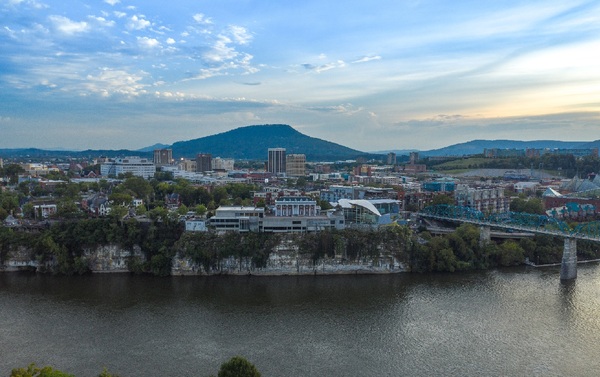
–>
June 24, 2023
Imagine, if you will (tip of the hat to Rod Serling), a small American town in the mid-South, located on the banks of a major river in a valley surrounded by beautiful mountains. Two major interstate highways pass through the town, making it the major north/south crossroads east of the Mississippi River. Heavily industrialized after WWII, however, this town eventually had the “dirtiest air in the U.S.,” surpassing even Los Angeles for that dubious distinction.
‘); googletag.cmd.push(function () { googletag.display(‘div-gpt-ad-1609268089992-0’); }); document.write(”); googletag.cmd.push(function() { googletag.pubads().addEventListener(‘slotRenderEnded’, function(event) { if (event.slot.getSlotElementId() == “div-hre-Americanthinker—New-3028”) { googletag.display(“div-hre-Americanthinker—New-3028”); } }); }); }
In the 80s and 90s, the powers-that-be decided to clean up this city and make it into an attractive tourist destination. Using Environmental Protection Agency (EPA) rules, they gradually forced out the foundries and other heavy industries, ignoring the plight of those who lost jobs; after all, they were “saving the environment.” And sure enough, tourism became a major part of its economy; a fresh-water aquarium was built (largely due to the influence of one of those powers-that-be), and a hugely successful annual music festival drew a hundred thousand music lovers each summer, exposing them to the delights of this town.
Being located in the Tennessee Valley, energy was cheap due to the Tennessee Valley Authority’s vast network of dams and two nuclear plants located nearby. A successful business incubation center helped develop all manner of businesses, one of which was high-speed internet interests that resulted in the city being dubbed “GIG City,” for being the first city in the nation to have that high-speed internet capacity. Which naturally attracted even more business.
This city is Chattanooga, Tennessee, my lifetime home until I retired two years ago to a small north Georgia town about thirty minutes south of the city, away from the increased traffic but still close to family, friends, church, etc.
‘); googletag.cmd.push(function () { googletag.display(‘div-gpt-ad-1609270365559-0’); }); document.write(”); googletag.cmd.push(function() { googletag.pubads().addEventListener(‘slotRenderEnded’, function(event) { if (event.slot.getSlotElementId() == “div-hre-Americanthinker—New-3035”) { googletag.display(“div-hre-Americanthinker—New-3035”); } }); }); }
Politically, the rank-and-file voters tend towards conservative values (although there is a hefty, and growing, liberal segment). So imagine my surprise the other day when I read that Chattanooga is one of the first two cities in the U.S. slated to become one of the World Economic Forum’s “15-minute cities.” As you surely know, the World Economic Forum (WEF) is Klaus Schwab’s globalist fantasy, the realization of which means we peons will ‘own nothing, and be happy.” In short, it’s Aldous Huxley’s Brave New World, updated.
Before we discuss what a “15-minute city” actually is, though, some background: In 2006, Mayor Ron Littlefield set targets to reduce greenhouse gases. In 2009 he created a Climate Action Plan and in 2012 issued an Executive Order to reduce energy, water, and waste by 2020. The Chattanooga Tea Party circulated a petition to recall Littlefield in 2010, but a county judge ruled that the recall “failed to comply with state law,” so Littlefield was able to institute his climate agenda.
In 2015, the city published its first SMART City Plan, and in 2020 Chattanooga was selected by the WEF as one of two pioneer U.S. cities (San Jose, California is the other one) “in a global initiative to use broadband and data to plan and utilize energy, transportation, health care and communications in more sustainable and equitable ways.”
A WEF White Paper from 2021 emphasized the necessity of using Artificial Intelligence (AI) and quantum computing to process data quickly and efficiently. Installing and implementing high-speed broadband is a foundational prerequisite for SMART cities. Remember that “GIG City” nickname? Well, in 2022, Chattanooga announced plans for the municipally owned utility (Electric Power Board) to launch “America’s first commercially available quantum network.”
 Now, about that 2023 Climate Action Plan: it seeks to reduce Chattanooga’s carbon footprint by 2050, and all solutions “will be implemented through an equity lens, so that all Chattanoogans… experience the benefits of a growing green economy and more sustainable city.” Folks, when you see the terms “green” and “sustainable,” as attractive as they seem on the surface, they are simply camouflage for some truly nefarious plans, including for transportation, buildings and waste, green spaces and waterways and jobs. The plan includes “…’solutions’ for decarbonizing the transportation sector and increasing cleaner, greener transportation options,” including software and signal upgrades that allow for “real-time monitoring and communication capabilities.” Keep that “monitoring and communication capabilities” in mind; more on that below.
Now, about that 2023 Climate Action Plan: it seeks to reduce Chattanooga’s carbon footprint by 2050, and all solutions “will be implemented through an equity lens, so that all Chattanoogans… experience the benefits of a growing green economy and more sustainable city.” Folks, when you see the terms “green” and “sustainable,” as attractive as they seem on the surface, they are simply camouflage for some truly nefarious plans, including for transportation, buildings and waste, green spaces and waterways and jobs. The plan includes “…’solutions’ for decarbonizing the transportation sector and increasing cleaner, greener transportation options,” including software and signal upgrades that allow for “real-time monitoring and communication capabilities.” Keep that “monitoring and communication capabilities” in mind; more on that below.
These green warriors that now run the city say that “buildings are the number one contributor to greenhouse gas emissions in Chattanooga,” and that the people who live and work in them cause unsustainable levels of waste that pollutes green spaces and waterways.
‘); googletag.cmd.push(function () { googletag.display(‘div-gpt-ad-1609268078422-0’); }); document.write(”); googletag.cmd.push(function() { googletag.pubads().addEventListener(‘slotRenderEnded’, function(event) { if (event.slot.getSlotElementId() == “div-hre-Americanthinker—New-3027”) { googletag.display(“div-hre-Americanthinker—New-3027”); } }); }); } if (publir_show_ads) { document.write(“
In other words, people are the enemy in the war of climate sustainability. That is the foundational creed behind the great “climate change” hoax that is threatening the very existence of western civilization.
Now, back to that “15-minute city” idea — 15-minute cities promote the ability to live, work, attend school, and play where you live without ever using a car. This concept has already been rolled out globally by the WEF. Chattanooga, my once-sleepy little hometown, has installed cameras with facial recognition software and license readers at most intersections, and is rezoning properties to high-density mixed-use designations. Surveillance is a critical component of the 15-minute City because it allows for the monitoring of non-compliant citizens. Facial recognition software is in wide use in Communist China as a means to control the populace through the fear that they will be seen and identified if they step out of line. And it’s right here in River City!
What about that “SMART city” concept? Proponents say it makes everyday life more sustainable and promotes equitable outcomes, but opponents point out that the SMART technologies are invasive and controlling, in that they monitor and report citizens who do not follow “Green rules.” SMART stands for “Surveillance…Monitoring…Analysis…Reporting…Technology.”
SMART meters and thermostats in your house track energy consumption in real-time and allow the energy company to control your temperature inside your own house! SMART water meters give control over your water consumption to the water company. In both cases, they can turn off your power and water when they decide that you’ve used too much. Don’t believe it? In September of 2022, thousands of Coloradans were locked out of there thermostats by the power company because of an “energy emergency” in the state.
NoogaVoices, the group opposing the Climate Action Plan and its climate change-based idiocy, says that “SMART intersections with cameras, facial recognition and license plate readers that record, analyze and report where you go, when you go, what time you go and how fast you go. They will track and report your CO2 emission and adjust your social credit score.” That social credit score, in use by Communist China, can be used to determine what you’re allowed to buy and when, or even if you’re allowed to buy it.
This is happening today, in my small hometown in the mid-south. All under the guise of “sustainability” and “equity,” which simply disguises the real agenda: control of American citizens.
The climate alarmists have made predictions of climate doom for over 50 years, and not a single one of them has even come close to matching reality. “Climate change” is a gigantic hoax, but one the whole world seems hell-bent on falling for. We’re allowing professional politicians enthralled by the WEF globalist fantasy that gives them total control, to destroy our rights and freedoms to combat a supposed climate emergency that exists only in their totalitarian fantasies.
Image: Breethol
<!–
–>
<!– if(page_width_onload <= 479) { document.write("
“); googletag.cmd.push(function() { googletag.display(‘div-gpt-ad-1345489840937-4’); }); } –> If you experience technical problems, please write to [email protected]
FOLLOW US ON
<!–
–>
<!– _qoptions={ qacct:”p-9bKF-NgTuSFM6″ }; ![]() –> <!—-> <!– var addthis_share = { email_template: “new_template” } –>
–> <!—-> <!– var addthis_share = { email_template: “new_template” } –>





